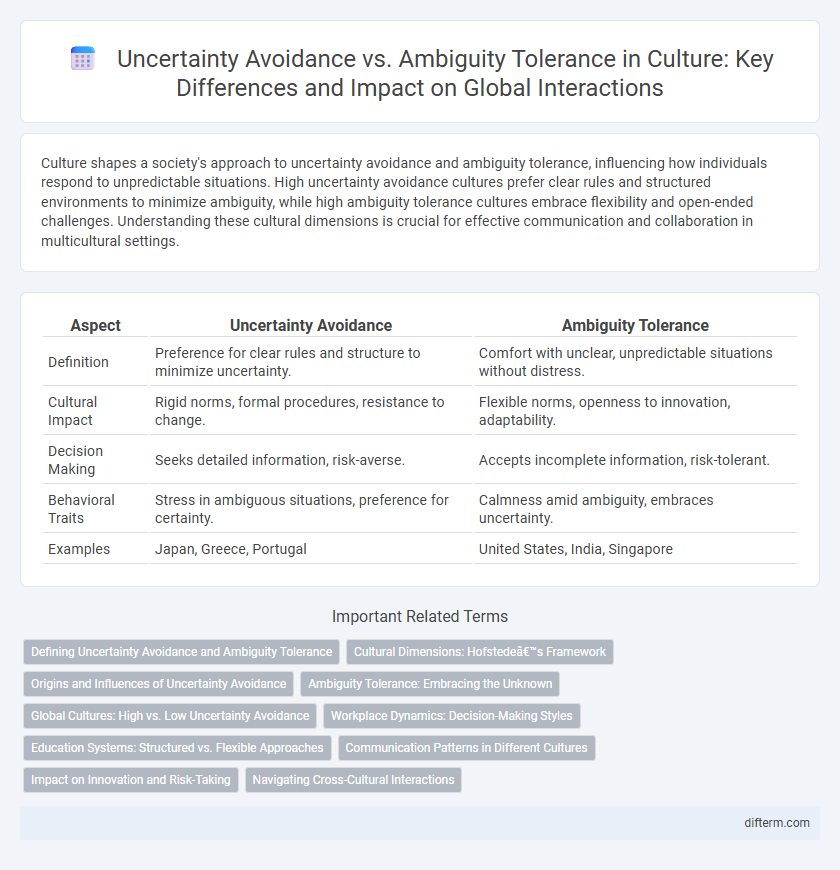Culture shapes a society's approach to uncertainty avoidance and ambiguity tolerance, influencing how individuals respond to unpredictable situations. High uncertainty avoidance cultures prefer clear rules and structured environments to minimize ambiguity, while high ambiguity tolerance cultures embrace flexibility and open-ended challenges. Understanding these cultural dimensions is crucial for effective communication and collaboration in multicultural settings.
Table of Comparison
| Aspect | Uncertainty Avoidance | Ambiguity Tolerance |
|---|---|---|
| Definition | Preference for clear rules and structure to minimize uncertainty. | Comfort with unclear, unpredictable situations without distress. |
| Cultural Impact | Rigid norms, formal procedures, resistance to change. | Flexible norms, openness to innovation, adaptability. |
| Decision Making | Seeks detailed information, risk-averse. | Accepts incomplete information, risk-tolerant. |
| Behavioral Traits | Stress in ambiguous situations, preference for certainty. | Calmness amid ambiguity, embraces uncertainty. |
| Examples | Japan, Greece, Portugal | United States, India, Singapore |
Defining Uncertainty Avoidance and Ambiguity Tolerance
Uncertainty avoidance reflects a culture's preference for clear rules, structured situations, and predictability to minimize ambiguous outcomes, often leading to strict laws and formalized procedures. Ambiguity tolerance describes the degree to which individuals or societies accept vague, unclear, or uncertain situations without becoming anxious or stressed. High uncertainty avoidance cultures emphasize control and clarity, whereas high ambiguity tolerance cultures embrace flexibility and innovation in uncertain environments.
Cultural Dimensions: Hofstede’s Framework
Uncertainty avoidance, a key dimension in Hofstede's cultural framework, measures a society's tolerance for ambiguity and uncertainty in daily life and organizational practices. Cultures with high uncertainty avoidance prefer structured environments and clear rules to minimize uncertainty, whereas cultures with ambiguity tolerance embrace flexibility, innovation, and risk-taking. This dimension significantly influences decision-making processes, communication styles, and conflict resolution across different cultural contexts.
Origins and Influences of Uncertainty Avoidance
Uncertainty avoidance originates from cultural values deeply rooted in historical, social, and psychological factors influencing how societies manage ambiguity and risk. Cultures with strong uncertainty avoidance tend to develop extensive rules, formal policies, and structured environments to minimize unpredictability, often shaped by past experiences of instability or conflict. Influences include religious beliefs, political systems, and educational frameworks that reinforce the preference for clear guidelines and security over open-ended or ambiguous situations.
Ambiguity Tolerance: Embracing the Unknown
Ambiguity tolerance reflects a culture's capacity to embrace uncertainty and adapt to new, unclear situations without stress or excessive need for rules. Societies with high ambiguity tolerance encourage innovation, flexibility, and open-mindedness, fostering creativity and diverse problem-solving approaches. Embracing ambiguity promotes resilience in dynamic environments and supports continuous learning and cultural evolution.
Global Cultures: High vs. Low Uncertainty Avoidance
Global cultures with high uncertainty avoidance prioritize clear rules, structured environments, and risk minimization to maintain stability and predictability. In contrast, cultures exhibiting low uncertainty avoidance demonstrate greater ambiguity tolerance, embracing flexibility, innovation, and adaptability in uncertain situations. This cultural dimension significantly influences management styles, communication patterns, and decision-making processes in multinational organizations.
Workplace Dynamics: Decision-Making Styles
Uncertainty avoidance influences workplace decision-making by favoring structured processes and clear rules that minimize ambiguity, leading to risk-averse behaviors and slower adaptation to change. In contrast, ambiguity tolerance encourages flexible, innovative approaches where employees embrace uncertainty, promoting creativity and faster response to unpredicted challenges. Organizations with high uncertainty avoidance typically rely on hierarchical decision-making, while those with ambiguity tolerance empower decentralized, experimental strategies enhancing dynamic problem-solving.
Education Systems: Structured vs. Flexible Approaches
Education systems with high uncertainty avoidance emphasize structured curricula, clear guidelines, and standardized testing to reduce ambiguity for students and educators. In contrast, cultures with greater ambiguity tolerance adopt flexible teaching methods, encourage open-ended inquiry, and value creativity over rigid assessment criteria. These differing approaches reflect broader cultural attitudes toward risk, predictability, and innovation within the classroom environment.
Communication Patterns in Different Cultures
Uncertainty avoidance influences communication styles by favoring explicit, clear messages and structured interactions, reducing misunderstandings in cultures with high uncertainty avoidance. Cultures tolerant of ambiguity display more indirect and context-dependent communication, relying on nonverbal cues and flexible interpretation. Understanding these patterns is crucial for effective cross-cultural communication and minimizing conflict in global interactions.
Impact on Innovation and Risk-Taking
Uncertainty avoidance cultures often prioritize structured environments and clear rules, which can limit risk-taking and slow innovation by discouraging experimentation and ambiguity. In contrast, ambiguity tolerant societies embrace uncertainty, fostering a creative mindset that encourages exploring novel ideas and taking calculated risks, thereby accelerating innovation processes. This cultural dimension strongly influences organizational behavior, affecting the willingness to invest in groundbreaking technologies and unconventional strategies.
Navigating Cross-Cultural Interactions
Uncertainty avoidance and ambiguity tolerance significantly influence cross-cultural interactions by shaping how individuals approach unfamiliar situations and interpret vague information. Cultures with high uncertainty avoidance prefer clear rules and predictable outcomes, fostering structured communication and reducing risks. Conversely, cultures with high ambiguity tolerance embrace flexibility and open-endedness, allowing for adaptive strategies and creative problem-solving during cross-cultural exchanges.
uncertainty avoidance vs ambiguity tolerance Infographic

 difterm.com
difterm.com